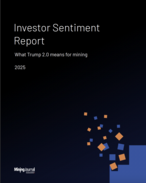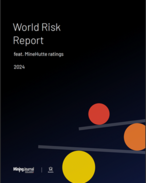With steady progress being made on the ground,
company president and CEO
Archived article: image not displayed.
Stephen Roman, CEO, Global Atomic Corp.
Stephen Roman hopes to wrap up project financing shortly as his team vies to bring what is Africa's largest highest-grade uranium project online in a little over two years from now.
Several pieces must fall into place in order for that to happen, but favourable uranium market conditions, a highly promising deposit, and a stellar team mean Roman is unphased. On the financing front, the CEO told Mining Journal he expected to have word on banking terms by the end of the year, which should give guidance on what additional equity capital might be needed.
Solving the funding equation - total capex is slated at US$208 million - would cap an impressive run for the industry veteran. In the last six months alone, Roman has already overseen, among other things, an initial offtake agreement, a successful negotiation with the government of Niger - which saw Niger double its stake in the project to 20% - and delivery of an impressive drilling programme.
For now, building out the customer base is a key priority. In addition to the two utilities already onboard, Roman says he has "a number of other discussions on the go" and is looking to sign up "a few more".
"We need to sell at least 1.5 million pounds a year to cover all our costs and our bank requirements. This mine, at 1,000t/d, is capable of processing and producing about 4.5 million pounds a year. Based on recent discussions with nuclear utilities, I think as we complete some of these milestones, you'll see more of these utilities sign on with us," Roman says.
A 2021 feasibility study for Dasa outlined an initial Phase 1 mine development over 12 years, producing 45.4Mlb and an after-tax NPV8% of US$157 million and an IRR of 22.7%, using a base case uranium price of US$35/lb.
With all-in sustaining costs slated at US$22/lb and OPEX costs already in the region of US$18-19/lb, Roman believes the company's recently expanded drilling programme will see OPEX costs fall even further.
"The feasibility study took into account developing the ore body along a 2km strike length. We don't need to develop those outlying areas right now - they are areas you could develop 30-40 years from now," Roman says. "Right now, the areas that our drill programme targeted were inferred resources around our Phase 1 area, which will allow us to mine in that area for many more years, decreasing the underground development required and lowering our cost."
The project's numbers look significantly better in the current price environment, just north of US$50/lb. Not that Roman thinks the bull run is anything like finished. On the contrary, he believes the forecast build-out of the global nuclear fleet, coupled with additional demand from small modular reactors (SMRs), could create a price spike on a par with 2007, when prices briefly touched US$140/lb.
"The current reactor fleet is already in a 60-80 million pound a year deficit. So if you double the reactor fleet, where are you going to get the fuel? Even if all the mines that are known today come on stream, their projected uranium supply doesn't handle the fuel requirement," Roman says.
This shortfall has been exacerbated by the Ukraine war, presenting Roman's company with an unexpected opportunity. "A lot of countries that were previously getting supplies from Russia are now speaking with us - they want a diversification of supply," he says.
Archived article: image not displayed.
Solar powered water pump near the Dasa Project
While Global Atomic has undoubtedly benefited from the recent buzz surrounding uranium, it was in a better position to capitalise on the favourable market conditions than many of its rivals. That is largely because, in the fallow years following the Fukushima disaster in 2011 when many juniors fell all but dormant, Roman's company took proactive steps to prepare for an uptick in prices. "A lot of people wait for markets to improve before they start doing their work," he says. "We did not wait. So that's why right now we're ahead of the game. And we're actually in construction currently to build the Dasa mine and definitely be one of the first producers out there in 2025 to take advantage of a better uranium market."
The sheer quality of Dasa certainly gives Global Atomic a significant leg up on the competition. The Tim Mersoï Basin, in which Dasa is located, shares many characteristics with Canada's Athabasca Basin, the world's leading source of high-grade uranium. In both instances, the uranium is contained in sandstone host rocks, much softer and easier to handle than, say, the granite mined until recently by Rio Tinto at Rossing in Namibia.
"We've been blessed with a fabulous large high-grade deposit that doesn't have a lot of metallurgical issues," Roman says. "It's basically a standard crush, grind, acid leach and precipitate, which a lot of other uranium projects use. However, based on what kind of rock they're found in, you could have many more issues recovering the uranium and processing it. We really don't have any big issues on our project."
As for the ‘Africa factor', Roman believes the strong American military presence - the US has its largest base in Africa just south of Dasa in Agadez - together with government buy-in should help soothe investors' nerves. "[The Niger government] very intently secures that area, as uranium production constitutes a very large portion of Niger's export revenues," he says. "The government makes sure that companies can operate there, and that they can continue producing revenue for the country."
























